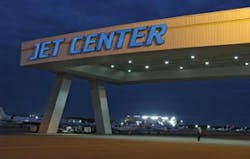Phil Botana, vice president and general manager of the Tampa Jet Center, relates that a few of the biggest ‘lessons learned’ from handling this year’s NFL Super Bowl involve planning, up front reservation fees, and locking up extra rooms for incoming pilots — but not too many.
“One of the things that was very impressive and we got a lot of kudos for after the fact is, the FAA and the airport came up with a really good plan for moving the planes out and limiting the number of aircraft that could land after the game, after the TFR was lifted, in order to accommodate departures,” he explains. “They were able to get about 160 aircraft out after the game.
“The last time it was in Tampa in 2001, because there were so many planes landing, it made it very congested for the airplanes that were parked to taxi out. So it took up to four hours to get all the planes that were leaving after the game.” Botana is quick to add that in 2001 the airport had only one full-service fixed base operation, versus two today.
“This time we got some 150 planes off the ground in an hour and a half. The way they metered the flow of the planes; the fact that they restricted arrivals for a couple of hours, made all the difference in the world.”
Following the Super Bowl in Miami two years prior, Botana spoke with FBOs all along the Southeast Florida corridor in preparation of the event coming to TPA. He reports, “Several said to lock up hotel rooms for the pilots; you can get their business if you have rooms for them. So, we locked up a bunch of rooms; because of the economy I got stuck with a lot of them. That would be something that I would have rethought. Half as many, I’m a happy camper. In another economy I would have been glad to have them.”
Tampa Jet Center and Signature Flight Support, the FBOs at the airfield, came to agreement to essentially split incoming general aviation aircraft for the event, excluding customers who had made specific reservations with a particular FBO.
Relates Botana, “The airport shut down the east/west crosswind runway, which they do for big events. This was the fourth time the Super Bowl was in Tampa; the airport authority staff had experience dealing with this at the airline terminal level as well as at the business aviation level.
“We came up with a plan with Signature as to how we were going to divvy that up, and that worked pretty well. There weren’t any big competitive issues.
“Other than what we could park on our own ramps, we had to be able to park all the other planes. The larger planes — Gulfstream category types -— would only fit on this runway. We wanted to park everything to be able to pull forward and taxi out from where it was parked. We didn’t have a lot of logistics of physically towing airplanes to departure spots, which can be cumbersome and time-consuming.
“We divided this runway in half, more or less.”
While the economic downturn and bad publicity for corporate aviation in late 2008 had a significant impact on the turnout, Botana estimates that some 320 transients arrived for the the event. Some additional 150,000 to 200,000 gallons of fuel were pumped by the two operations, he says.
Botana was able to recruit additional service personnel from FBOs in Florida, whom Tampa Jet Center paid and housed. Fuel supplier AirBP also provided personnel assistance, and oversaw the company’s fuel farm quality control.
Says Botana, “One of the bigger challenges for us was the fact that we’re independent. Signature is likely to have an event at some location every year, so they’ve got the know-how that they can bring in from other places. I was able to reach out to a half a dozen FBOs in Florida, all of whom are independents. A lot of them did it as much for the experience. Some of them had had big events at their airports in the past.”
Cross-checking revenues versus expenses for the event, the Tampa Jet Center turned a profit on it, according to Botana. “We made a little bit; not any windfall,” he comments.
“One of the things we did that made a difference for us financially was we established an event fee because of all the expense that we knew we were going to incur. It varied by size of airplane, from $350 to $650, regardless of whether they bought fuel or not. People didn’t have a problem with it. The fees were reasonable enough. We collected it at the time they made the reservation.” That lesson learned, he says, came from the Glendale (AZ) Airport’s experience with the 2008 Super Bowl, which had a significant amount of no-shows. Glendale had not charged an event fee in advance.
“The fees represented $80-90,000,” says Botana. “That made a big difference for us. Signature didn’t take that approach; they were charging their normal ramp fees, but not in advance.”
The airport hired an independent ground handling company to help with departures, charging $30 per aircraft.
According to Botana, the greatest benefit from handling a Super Bowl came from the exposure received by bizjet customers, particularly for the relative newcomer at TPA.
“To me it’s more important that we do a good job and impress people as an independent. That’s my first goal.
“The second goal is to not have it cost money; but the primary objective was to do a good job and enhance our reputation.”






